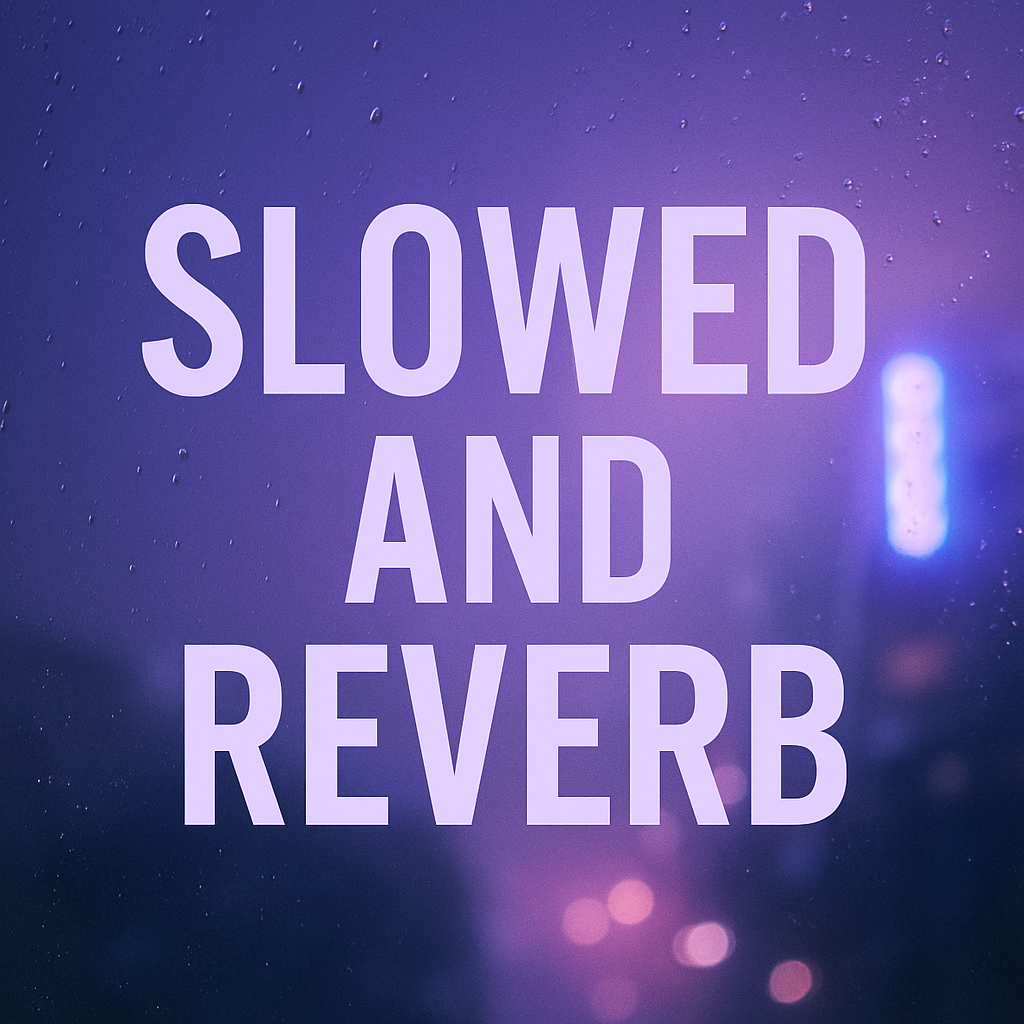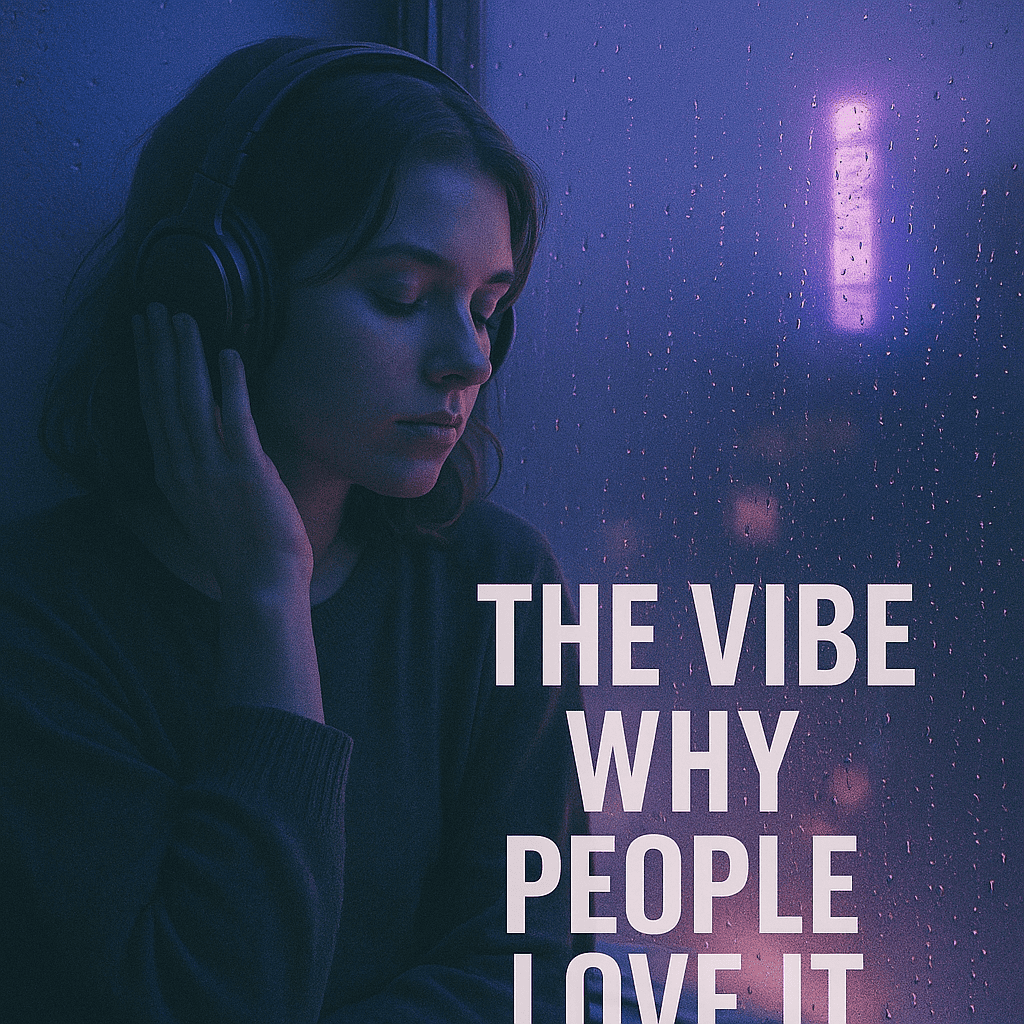It’s 2 a.m. You’re lying on your bed, phone dimmed, headphones in. A familiar song plays—but something feels different. Slower. Softer. Like it’s echoing through a memory you don’t quite recall. The vocals stretch, the beat lags gently, and reverb gives it that haunting sense of space. You’re not just listening—you’re feeling.
That’s slowed and reverb, and if you’ve ever been caught in the rabbit hole of YouTube edits or TikTok loops, you know exactly what I mean.
Over the past few years, slowed + reverb has exploded from niche corners of the internet to mainstream culture. From nostalgic edits on TikTok to hours-long YouTube loops, this dreamy audio style has become a soundtrack for a generation navigating feelings, memories, and quiet chaos.

The Basics – What is Slowed and Reverb?
At its core, slowed and reverb is exactly what it sounds like: a song that has been slowed down in tempo, and layered with reverb, a sound effect that mimics how audio would echo and reflect in a large, empty space.
- Slowing the track decreases its beats per minute (BPM), stretching the vocals and instrumental elements. The music feels weightier, often more emotional.
- Reverb adds echo, creating the illusion that the music is playing in a vast room or drifting through mist.
Together, they produce a surreal, dreamy experience. Imagine listening to your favorite upbeat song—but now it feels like it’s swimming through water or playing in the background of a faded dream.
It’s not a complicated technique, but the emotional punch it packs? That’s the magic.
History & Origins: From Screw to Slowed
To really understand slowed + reverb, we need to rewind.
In the 1990s, Houston legend DJ Screw pioneered a style called chopped and screwed—a slowed-down, pitch-altered remix of Southern hip-hop. It was gritty, raw, and often paired with heavy bass and psychedelic elements. DJ Screw would literally slow cassette tapes by hand, dragging the beat and pitch to create a syrupy, hypnotic vibe that felt unlike anything else at the time.
Fast-forward a couple of decades: YouTube creators started to experiment with a gentler version of this. Tracks were slowed down—but without the heavy chops or pitch distortion. Reverb was added to give space and depth.
Early Examples
One of the most viral early examples? A slowed + reverb edit of Lil Uzi Vert’s “20 Min” that racked up millions of views. Suddenly, this wasn’t just a remix style—it was an entire vibe.
Channels like Rum World, Hound Dog, and countless others took off. They paired their edits with moody anime visuals or looped vaporwave-style animations. The sound and aesthetic merged—and a micro-genre was born.
The Vibe – Why People Love It?

So why does this hit so deep?
On Reddit, someone wrote:
“It feels like a memory I never had. Like a dream I forgot but still feel.”
Another person put it this way:
“It slows you down. It forces you to feel the music, not just hear it.”
Slowed + reverb has this strange ability to make any song—pop, hip-hop, R&B, even EDM—feel melancholic, introspective, and personal. Lyrics become more pronounced. Instrumentals stretch like liquid. It’s like peeling back a song’s surface and stepping into its soul.
The style is often associated with vaporwave, lo-fi hip-hop, and synthwave—all aesthetic-heavy genres that romanticize time, space, and memory. But slowed + reverb takes that nostalgia and distills it into sound.
There’s something about hearing a familiar song in this altered way that creates a sense of distance—like looking at a photograph of your childhood bedroom. It’s the same, but not really. That emotional dissonance is why people keep hitting replay.
TikTok & Internet Culture Impact
Slowed + reverb didn’t just find a home on YouTube. It exploded on TikTok.
Creators began using slowed edits in their aesthetic montages—slow-mo sunsets, rainy windows, late-night car rides, introspective mirror shots. Suddenly, tracks like “Summertime Sadness” by Lana Del Rey or “505” by Arctic Monkeys were making the rounds in slowed and reverbed versions.
Some audios became so iconic that TikTok users sought out the full version—only to realize it wasn’t even an official remix.
Accounts like Shawty Compilations helped popularize these edits, curating slowed tracks with visually cohesive clips. These edits became shorthand for moods: heartbreak, nostalgia, calmness, even dissociation.
This format especially resonated with Gen Z, a generation already fluent in memes, aesthetic expression, and emotional self-reflection. For them, slowed + reverb became more than just a trend—it was a coping mechanism, a way to feel less alone in the quiet.
Is It Just a Trend? Or a Genre?
This question pops up all over Reddit: Is slowed + reverb just a TikTok fad? Or is it actually a genre?
Truth is, it’s somewhere in between.
On the surface, it seems simple. Anyone with Audacity and a YouTube link can make a slowed + reverb track in minutes. That DIY aspect makes it feel casual, almost disposable.
But there’s intention and creativity in doing it well. Picking the right track. Slowing it just enough to evoke emotion, but not drag. Adding the right type of reverb—plate, hall, cathedral. Choosing a visual loop that enhances the mood. In that way, it’s more art than trend.
Some purists argue that it’s ripping off chopped & screwed without acknowledging its roots. Others, especially Gen Z, see it as a natural evolution—just like lo-fi remixes or hyperpop remakes.
Whatever side you fall on, it’s hard to deny: slowed + reverb has staying power.
Legal & Artistic Discussions
Of course, with popularity comes controversy.
Slowed + reverb remixes often run into copyright issues. Since they’re based on existing songs, many get flagged, demonetized, or even taken down. YouTube and SoundCloud crackdowns have forced many creators to post anonymously or abandon their channels entirely.
There’s also a conversation around artistic respect. Some fans of DJ Screw and chopped & screwed culture feel like the current slowed + reverb wave is a watered-down, uncredited version of what came before. There’s a tension between honoring the origin and adapting it for new audiences.
Still, many slowed + reverb creators credit the original artists, link to their music, and frame their work as emotional reinterpretation rather than theft.
How to Make It Yourself
Want to try making a slowed + reverb track? You don’t need a fancy setup.
Tools You Can Use:
- SSSlowedReverb (free)
- Audacity (free)
- FL Studio
- Ableton Live
- Online editors like [ssslowedreverb.com] or browser-based DAWs
Basic Steps:
- Import the track
- Slow the tempo to ~85–95% (don’t change pitch unless you want that effect)
- Add reverb – usually Hall or Plate for spacey vibes
- Tweak EQ – cut some highs, boost some mids/lows
- Render & export.
Bonus points if you pair your audio with looping visuals—anime clips, cityscapes, retro edits, or glitchy VHS overlays.
Closing Thoughts: A Feeling in Sound
Slowed and reverb isn’t just an effect. It’s an experience.
In a world that moves too fast, this sound slows us down. It gives us permission to linger, to feel things deeply—even if we don’t fully understand them.
It turns music into memory, songs into spaces.
And maybe that’s why it’s resonated so deeply. Because for a few minutes, you’re not just hearing a song—you’re living inside it.
FAQs
Slowed and reverb refers to a remixing style where a song is slowed down in tempo and enhanced with reverb (echo effect) to create a dreamy, atmospheric feel. It gives the song a more emotional, nostalgic, and spacey vibe.
While slowed and reverb as we know it today became popular on YouTube and TikTok in the late 2010s, its deeper roots trace back to the 1990s with Houston DJ DJ Screw, who pioneered the “chopped and screwed” style—an early form of slowed-down hip-hop.
Not exactly. Chopped and screwed involves slowing the tempo and adding DJ-style techniques like scratching and repeating sections. Slowed and reverb is usually smoother and more ambient, focusing on emotional atmosphere rather than DJ chops.
Many listeners say it evokes nostalgia, introspection, and emotion. Slowing a song allows you to absorb the lyrics and instrumentation more deeply, and reverb adds a surreal, echoey atmosphere—almost like drifting through a memory.
Technically, most slowed and reverb edits use copyrighted material and can be flagged by platforms like YouTube or SoundCloud. However, many creators post under fair use for non-commercial, transformative purposes. Still, official licensing is recommended for monetization.
Yes! With basic audio editing tools like Audacity (free), FL Studio, or browser-based editors, anyone can slow down a track and add reverb. It’s easy to learn, but mastering the vibe takes creativity and taste.
Not all songs translate well. Tracks with rich instrumentation, emotional vocals, or slower tempos tend to work best. Upbeat pop or complex EDM may lose their energy when slowed, but sometimes that contrast creates a new, haunting feel.
Popular YouTube channels include Rum World, Hound Dog, Truly Slowed, and Shawty Compilations. On streaming platforms, look for slowed versions by artists like Slater, daycore creators, or fan-made edits tagged “slowed + reverb.”
While TikTok helped popularize the sound, slowed and reverb has roots in deeper internet culture and music communities. It’s now considered a microgenre, especially among Gen Z and lo-fi/vaporwave fans, and continues to evolve.
You’ll need permission or a license from the original rights holder. Platforms like DistroKid offer remix licensing options. If you’re working with royalty-free music or your own original tracks, you can remix and publish without issue.

Candy is the social media manager and resident content creator at SSSlowedAndReverb. A DJ herself, she brings her deep love for slowed and reverb music into every post, blending real-world experience with internet culture to create content that resonates with fans and creators alike.